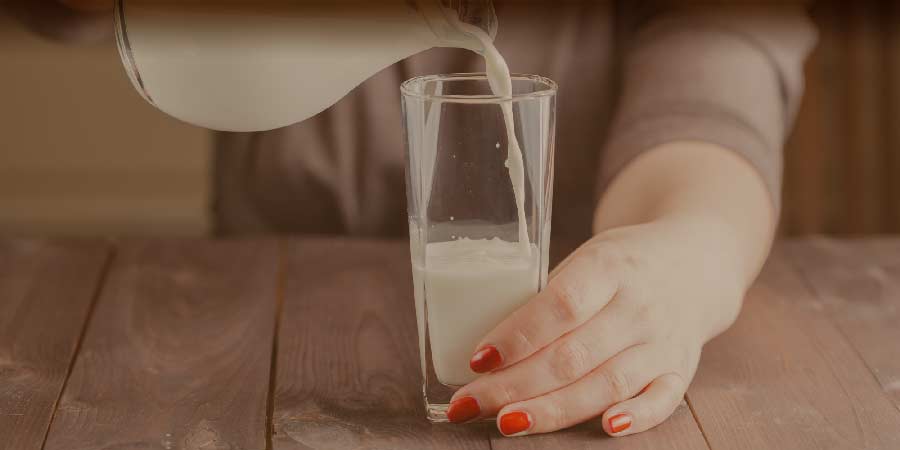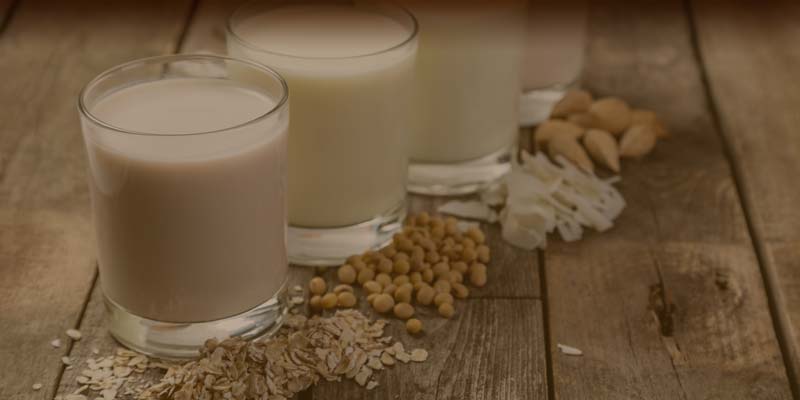Babies and toddlers grow and develop rapidly so they need plenty of calories and nutrients to support these changes. Dairy products such as milk, cheese and yogurt provide a wide range of nutrients and are important foods during this stage of life.
Here, we answer all your questions about dairy products in the diets of babies and toddlers…
Q: When should I start weaning?
A: Babies are born with a store of nutrients in their bodies that, together with breast milk or infant formula, provide all the nourishment they need for the first six months of life. But after this time, growing babies begin to need more nutrients, which they can only get from a more varied diet. The NHS recommends starting to introduce solid foods – what many of us call weaning – when babies are about six months old. The aim of weaning is to gradually introduce a wide range of tastes and textures, over time increasing the amount and variety of foods that babies try so that by around their first birthday they’re enjoying three balanced, nutritious meals a day.
Q: What foods should I give to my baby when I start weaning?
Good first foods to offer alongside your baby’s usual breast milk or infant formula include small amounts of individual fruits and vegetables such as sweet potatoes, broccoli, parsnip, yam, carrots, apples or pears that have been blended, mashed or soft cooked and cooled. As well as sweeter veg like carrots and butternut squash, it’s a good idea to include ones that are less sweet such as cauliflower and spinach to help your baby get used to a range of flavours. Don’t add any salt or sugar to them. You can also give baby cereal mixed with their usual breastmilk or infant formula.
Check out Dairy UK’s Menu Planner 1 for when you first start weaning.
The preferences that babies and young children develop in their first few years can stick with them for life so it’s important to provide a variety of nutritious foods, flavours – and a balanced diet – right from the start.
Q: When can I introduce cow’s milk into my baby’s diet?
A: You can introduce pasteurised whole cow’s milk in cooking or mix it with your baby’s food when you start weaning at around six months. However, you should continue to give them breastmilk or infant formula as their main drink to provide them with all the calories and nutrients they need while they’re getting used to solid foods and only eating very small amounts. As weaning progresses and babies begin to eat a more varied diet, they begin to get more of their calories and nutrients from food. This means by the age of one, babies can start to have whole cow’s milk as their main drink, although you can continue breastfeeding for as long as you both want.
Q: When can I start to give my baby other dairy products?
A: It’s fine to give cheese and plain, unsweetened yogurt to babies from six months when weaning begins. You should give whole fat dairy products as they can help to meet a growing baby’s needs for calories. Make sure cheese is pasteurised (see below) and try cream cheeses – they’re usually lower in salt than hard cheese. Make sure yogurts don’t contain any added sugar.
Q: When can my baby start to drink cow’s milk?
Breastmilk or infant formula should be the main drink for babies for the first year. From the age of one, you can give pasteurised whole cow’s milk as a drink, although you can continue breastfeeding for as long as you both want. It’s fine to use whole cow’s milk in cooking or mix it with other foods from six months though when weaning begins.
Q: What sort of milk should toddlers and young children have?
From the age of one, children can have pasteurised whole cow’s milk as a main drink. Children over the age of one can also be given semi-skimmed milk providing they are eating and growing well. You should wait until children are five years of age before switching to 1% fat or skimmed milk as they are lower in calories and some key nutrients, and so might not provide enough for young growing children. From the age of one, milk should always be given in a cup or mug rather than a bottle.
Q: What cheese is best for babies and toddlers?
Cheese can be given to babies from six months when weaning starts. For babies and children up to the age of two, choose whole fat varieties – this will help to provide the calories that growing children need. Cheese should be made from pasteurised milk – this is the case for most cheeses bought from supermarkets but check labels on packaging to make sure. It’s best to avoid giving babies and young children mould-ripened cheeses such as brie and camembert, ripened goat’s milk cheese and soft blue veined cheese as they may be more likely to carry listeria bacteria. You can use these cheeses in cooking though as listeria is killed by high temperatures.
Q: Which yogurts are best for babies and toddlers?
Choose unsweetened plain yogurt – check labels to make sure they contain no added sugar. For babies and children under two, choose whole milk yogurts – they can help to provide the calories that growing children need.
Q: Why are dairy products so important for babies and young children?
Dairy products – milk, cheese and yogurt – are rich in a variety of nutrients that are important for everyone, including babies and young children. In particular, they provide protein, calcium and phosphorus, three nutrients that are needed for the normal growth and development of bone in children. Protein also contributes to muscle growth. Plus, milk and yogurt are rich in iodine, a nutrient which supports growth in children.
Q: How much dairy should my toddler have each day?
By the time babies have reached their first birthday they should be enjoying three meals a day containing a variety of different foods from the four main food groups. As part of this, according to the NHS, you should give your child 350ml of milk each day. Alternatively, you can give other dairy products such as cheese or yogurt. To help children enjoy a wide range of tastes, textures and flavours, aim to provide two to three daily servings of dairy products (adapt portion sizes according to your child’s appetite), mixing up the choices you offer.
Q: What’s a suitable serving size for dairy products for toddlers?
Knowing how much food to give young children can be difficult as appetites will vary from day to day and meal to meal – and, of course, will depend on a child’s age, size and how active they have been during the day. But as a guideline, suggested serving sizes for dairy products for young children are…
- 1 small glass (around 100-120ml) milk
- 60-80g of plain yogurt
- Around 15g – 2-3 dessert spoons – of grated cheese
Q: How much calcium do babies and toddlers need each day?
There are specific guidelines for nutrients at specific ages and stages in life for people living in the UK. These recommend that babies between the age of 0-12 months have 525mg calcium a day. Giving your baby breastmilk or infant formula exclusively for six months and then continuing with it as a main drink until the age of one while you are weaning will help to ensure these needs are met. From the age of one to three years, it’s recommended children have 350mg of calcium a day.
You can see how much calcium there is in different foods here.
Q: How can I include dairy products in my child’s diet?
Milk
- Offer a mug, cup or beaker of milk (for children aged one and above)
- Use milk (rather than water) to make porridge
- Serve breakfast cereals with milk
- Make custard – don’t add much or any sugar and instead serve with sliced banana or other fruit for dessert
- Blend milk with fruit to make a milkshake.
Cheese
- Slice or grate cheese for a tasty snack – add some fruit slices or vegetables, too
- Top toast with cream cheese or cheese spread
- Use cream cheese in place of butter or spreads when making sandwiches
- Serve a cheese sauce with cooked pasta, steamed fish (make sure it’s free from bones) or vegetables such as cauliflower, broccoli or carrots
- Top pasta dishes with a little grated cheese
- Combine grated cheese with breadcrumbs to top cottage pie or fish pie – then pop under the grill for a few minutes until golden and melted.
Unsweetened plain yogurt
- Stir into soft cooked and pureed fruit such as apple, pear, mango or peach. As well as adding creaminess, it will help cool down fruit that’s just been cooked – perfect when weaning starts!
- Stir yogurt into curries to help make them creamier and tastier for young tummies.
- Mix a spoonful with pureed or mashed ripe banana for a DIY fruit yogurt.
- Add a spoonful to pureed or mashed vegetables such as carrots, parsnips, butternut squash, sweet potato, peas, cauliflower or spinach.
- Mix into pureed or mashed potato to add creaminess.
- Mix with mashed egg, or tinned tuna or salmon (use varieties canned in water and take care to make sure it contains no bones) instead of mayo then use as a filling for sandwiches or a topping with jacket potatoes.
- Mix with grated cucumber – you could even add a little garlic and lemon juice for flavour – and serve with pepper sticks for a snack.
- Blend with pureed fruit then pour into lolly moulds and freeze for delicious lollies that make tasty alternatives to ice cream.
Q: How common is an allergy to cow’s milk in children?
An allergy to cow’s milk is estimated to affect around seven percent of babies under one year old, but most children grow out of it by the time they are five. Most often, it develops when a baby is first introduced to cow’s milk, either in infant formula or when breast-fed babies are introduced to dairy products during weaning. In very rare cases, the proteins in cow’s milk that are responsible for causing an allergy, can pass into breastmilk from the mum’s diet and so babies who are exclusively breastfed can still suffer.
For the small percentage of children with cow’s milk protein allergy, reactions can come on very quickly, beginning within a few minutes of having cow’s milk or can take longer, beginning hours or even days later. An allergy to a food such as milk involves the immune system, causing symptoms such as itchy rashes, swelling of the lips, eyes and face, vomiting, colic, diarrhoea or constipation, a runny nose, eczema that doesn’t improve with treatment or, in extreme cases, anaphylaxis where the tongue and throat swell, requiring urgent medical attention.
If you are concerned your baby or child suffers with an allergy to cow’s milk protein, it’s vital you see your GP for help. You should never try to manage the condition in your baby or child without medical input as breast milk or infant formula is the sole source of nutrition for babies and cow’s milk remains an important provider of nutrients in childhood.
For more information on cow’s milk allergy visit https://www.allergyuk.org/resources/does-my-child-have-a-cows-milk-allergy/
Q: Could my child suffer with lactose intolerance?
Lactose intolerance can develop at any age, with many cases first occurring in people aged between 20 and 40 years. It is also more common among some populations – such as Asian and African-Caribbean. However, babies and young children can still be affected. In many cases, it’s a temporary problem that’s caused by an infection in the digestive system. If you think your baby or child has lactose intolerance, always consult your GP for advice.
You can find more information about lactose intolerance here.
Q: Can I get help with buying milk for my child?
To help give children a good nutritional start in life, the English Government runs the Healthy Start Scheme. It allows pregnant women and parents with young children on low incomes to exchange vouchers for free milk, fruit, vegetables and infant formula. The vouchers can be used in shops taking part in Healthy Start, and also with local milkmen. You can also get free vitamins.
To find out more about Healthy Start visit here or ask your health visitor.
Further information:
For detailed information about weaning visit the NHS website.
For detailed information about feeding young children visit the NHS website.
Menu planner 1
Baby’s first foods
Menu planner 2
Baby’s first family meals
Go for variety
For one-to-fives
Menu ideas
For one-to-fives
Last reviewed: 09/2022
Next review due: 09/2024











